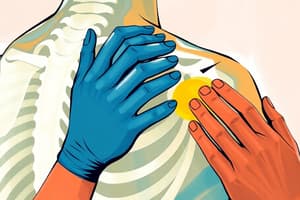Podcast
Questions and Answers
Which joint is the most frequently dislocated major joint?
Which joint is the most frequently dislocated major joint?
- Knee joint
- Hip joint
- Glenohumeral joint (correct)
- Elbow joint
What is the usual mechanism for an anterior glenohumeral dislocation?
What is the usual mechanism for an anterior glenohumeral dislocation?
- Fall on the extended arm with the shoulder in flexion
- Fall on the extended arm with the shoulder in extension (correct)
- Fall on the flexed arm with the shoulder in extension
- Fall on the flexed arm with the shoulder in flexion
Where does the humeral head come to lie in an anterior glenohumeral dislocation?
Where does the humeral head come to lie in an anterior glenohumeral dislocation?
- Lateral to the glenoid, just above the coracoid process
- Lateral to the glenoid, just below the coracoid process
- Medial to the glenoid, just above the coracoid process
- Medial to the glenoid, just below the coracoid process (correct)
What percentage of shoulder dislocations are accounted for by posterior dislocations?
What percentage of shoulder dislocations are accounted for by posterior dislocations?
What is a common cause of posterior dislocation?
What is a common cause of posterior dislocation?
Is glenohumeral dislocation a common injury in children?
Is glenohumeral dislocation a common injury in children?
What is a key clinical feature of posterior dislocation?
What is a key clinical feature of posterior dislocation?
Which type of radiograph is better for diagnosing posterior dislocation?
Which type of radiograph is better for diagnosing posterior dislocation?
What are some complications of glenohumeral dislocation?
What are some complications of glenohumeral dislocation?
What is the usual treatment for glenohumeral dislocation?
What is the usual treatment for glenohumeral dislocation?
Which method is used for reducing a shoulder dislocation where the elbow is bent to 90 degrees and slowly rotated externally to 75 degrees?
Which method is used for reducing a shoulder dislocation where the elbow is bent to 90 degrees and slowly rotated externally to 75 degrees?
What is the recommended period of immobilization after closed reduction of a shoulder dislocation in younger patients?
What is the recommended period of immobilization after closed reduction of a shoulder dislocation in younger patients?
What is the main risk in younger patients after closed reduction of a shoulder dislocation?
What is the main risk in younger patients after closed reduction of a shoulder dislocation?
What is the most common nerve injury associated with shoulder dislocation?
What is the most common nerve injury associated with shoulder dislocation?
What percentage of patients over the age of 50 with shoulder dislocation have nerve injuries?
What percentage of patients over the age of 50 with shoulder dislocation have nerve injuries?
What is the recommended imaging modality to diagnose a rotator cuff tear in patients who have not regained active abduction by 4-6 weeks after injury?
What is the recommended imaging modality to diagnose a rotator cuff tear in patients who have not regained active abduction by 4-6 weeks after injury?
What is the frequency of rotator cuff tears or greater tuberosity fractures in glenohumeral dislocations?
What is the frequency of rotator cuff tears or greater tuberosity fractures in glenohumeral dislocations?
When is early mobilization encouraged after closed reduction of a shoulder dislocation?
When is early mobilization encouraged after closed reduction of a shoulder dislocation?
What is the most common type of fracture associated with posterior dislocations of the shoulder?
What is the most common type of fracture associated with posterior dislocations of the shoulder?
What is the frequency of recurrent dislocation in patients under the age of 20 with shoulder dislocation?
What is the frequency of recurrent dislocation in patients under the age of 20 with shoulder dislocation?
Flashcards
Most dislocated major joint?
Most dislocated major joint?
The glenohumeral joint.
Mechanism for anterior dislocation?
Mechanism for anterior dislocation?
Fall on the outstretched, extended arm.
Location of humeral head after anterior dislocation?
Location of humeral head after anterior dislocation?
Medial to the glenoid, below the coracoid process.
Common cause of posterior dislocation?
Common cause of posterior dislocation?
Signup and view all the flashcards
Key feature of posterior dislocation?
Key feature of posterior dislocation?
Signup and view all the flashcards
Complications of glenohumeral dislocation
Complications of glenohumeral dislocation
Signup and view all the flashcards
Usual treatment for glenohumeral dislocation?
Usual treatment for glenohumeral dislocation?
Signup and view all the flashcards
Reduction method involving elbow rotation?
Reduction method involving elbow rotation?
Signup and view all the flashcards
Immobilization after reduction (younger patients)?
Immobilization after reduction (younger patients)?
Signup and view all the flashcards
Main risk in younger patients?
Main risk in younger patients?
Signup and view all the flashcards
Most common nerve injury?
Most common nerve injury?
Signup and view all the flashcards
Imaging for rotator cuff tear?
Imaging for rotator cuff tear?
Signup and view all the flashcards
When is early mobilization encouraged?
When is early mobilization encouraged?
Signup and view all the flashcards
Common fracture with posterior dislocations?
Common fracture with posterior dislocations?
Signup and view all the flashcards


